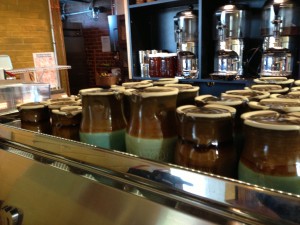Last Sunday night, our church offered the last of a three week series called Forgetting but Not Forgotten: Alzheimer’s and Faith, the final gathering focusing on congregational responses to dementia. Lisa Gwyther the director of the Duke Alzheimer’s Family Support Program began the session by reciting a line from an Antonio Machado poem:
traveler, there is no path,
the path is made by walking . . .
The lines gave her room to say she was not offering prescriptive advice, but offering what others had done or were doing as they walked the difficult road of dealing with dementia and Alzheimer’s. Part of the task, she said, was to find a metaphor that works; and then she said, “Life is a poetry.”
Needless to say, I wrote that down.
This past Sunday, a change in the broadcast schedule for WUNC, our local NPR station, meant I got to hear the TED Radio Hour instead of reruns of Car Talk. The episode playing was called “The Creative Process” I spent my twelve minutes in the car listening to Billy Collins talk about “When Does Creativity Start and End?” As he talked and I drove, I found myself building a bridge between the two talks, the two Sundays, using the building blocks I had found along the path the fast few weeks.
Sitting in the Alzheimer’s gathering, I was transported back to my CPE days as a chaplain at Baylor Medical Center in Dallas and one particular article that has stuck with me, even though the citation has not. The writer was offering his take on how to help people facing life-changing or life-ending news, focusing on those who asked, “Why is God doing this?” or “Why is this happening to me?” The why questions were not helpful, he said, because they led to shame or blame and, more importantly, they were not answerable in any sort of redeemable way. He challenged me to think of how I might offer a different question — one that offered the possibility of a path: what does this mean? “Making meaning” has become more cliché in the years hence, I suppose, yet I learned something from the article that has stuck with me.
As Collins discussed what he had learned about teaching students about poetry, he talked about mistakes he and others making in the classroom, most notably “the emphasis on interpretation to the detriment of the other less teachable and more obvious bodily pleasures a poem offers — rhythm, sound pleasures, metaphor, imaginative travel — not teachable.” He continued,
When I’m writing a poem that’s the last thing I’m thinking about; I’m never thinking about ‘What does the poem mean.’ I’m just trying to advance the poem to some point where it can stop.
He went on to say he tried to offer other questions for his students:
- how does the poem go?
- how does the poem progress?
- how does it get from its beginning to its end?
I’ve since gone back and listened to the program again to get the quotes down correctly, but as I drove last Sunday the question I carried with me into church was “Where is the poem going?” And I could here Lisa quoting Machado: “Traveler, there is no path . . . .” Carla, our Minister of Christian Education preached using the passage from Luke 5 where Jesus calls his disciples to follow him promising to make them “fishers of people.” She began her sermon by pointing out that we spend our lives saying, “Yes” to extraordinary offers without knowing what to do or what will happen next: marriage, children, jobs; the list went on. These are full and uncertain days for me, even as they are wonder-full and compelling. Still, I could see I was heading toward Lent like an old pickup careening down the hill without much to show for breaks.
In the midst of all that was swirling, I began to catch a glimpse of poetry in my life in the tethers that connected ideas over years and circumstance. The writer from my chaplain days had called me to move from asking “Why is this happening?” to “What does it mean for me?” Now the poets were calling me to move from focusing on the meaning to asking, “Where is this going?” As Collins pointed out, the question means every part of the poem (after all, Lisa Gwyther said, “Life is a poetry.”) is worth noticing from sunrises to sorrows, mistakes to metaphors, pressures to prayers, laughter to loneliness, futility to faith.
The power in the question, I am finding, is not in the answer, which is — at least for me — “I don’t know.” As compelling as Machado’s words are, I am finding there is a path: a well-worn path of those who have gone before me in grief and pain and uncertainty and faith. The question calls me to see we are not alone. Jesus said, “Follow me” a number of times, but he never said where; the call was to go with him. To live in relationship, in community, to walk together.
At the depth of my depression, one of the songs that kept me tethered was Patty Griffin’s “When It Don’t Come Easy.” I clung to the chorus because it was an achingly beautiful image of the tenacious love I felt from Ginger in those days who held on to me with amazing patience and determination.
if you break down, I’ll drive out and find you
if you forget my love, I’m there to remind you
and stand by you when it don’t come easy
As I type those words written indelibly on my heart, I find myself wanting to change the question one more time: not “Where is life going?” but “Where are we going?” Whatever the path, the answer is that matters most is, “Together.”
Peace,
Milton




